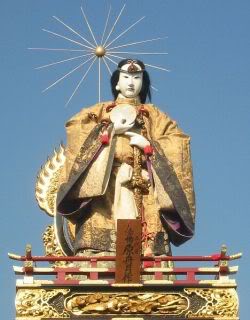
Ame no Minaka Nushi no Kami
The other day when I went to a lecture about the Kojiki (old book of Japanese myths and namesake of my blog’s URL), I heard about an interesting theory that aligned Shinto with Christianity. Shinto does not have any strict doctrine or theology. That is one of Shinto’s characteristics. Thus this theory is just some people’s interpretations. It is not right or wrong or anything in-between.
According to this theory, Shinto is a monotheistic religion. Wait. What you say? Shinto is usually called a polytheistic religion because of the “80 thousand” (yaoyorozu) gods it has! Shinto does indeed have many different kami. Among the well known kami, there are the three siblings Tsukiyomi, Susanowo, and Amaterasu. There are the parent kami Izanami and Izanaki. There are the Izumo kami such as Onamuchi and Sukunabikona. These are all mythical kami from the Kojiki. I also have an encyclopedia of kami that includes only real people that has over 13 hundred entries. How could Shinto possibly be monotheistic?
Christianity is a monotheistic religion, right? Yet the Christian God is a trinity. The Christian conception of God has three persons in one God. In this way, Christianity draws a difference between persons and essence. Shinto is the same.
The first kami to appear in the Kojiki is Ame no Minaka Nushi no Kami. This kami is very mysterious and becomes out of nothing, different from most of the other kami who are physically born into this world. Thus we can take this name “Ame no Minaka Nushi no Kami” as the name of “God”. All the other 80 thousand kami are of the same essence as Ame no Minaka Nushi no Kami, but different persons from her.
To clarify, in Christianity, there is “God” and he is made up of three persons: the Father, the Son, and the Holy Spirit. These three persons are all a single “God” and share the same divine essence equally. In Shinto (according to this theory), there is “God” and it is made up of Ame no Minaka Nushi no Kami and all the other 80 thousand kami. All these kami are a single “God” and share the same divine essence equally.
Continuing along this line of thought produces some interesting ideas to consider. We humans are children of the kami, literal blood descendants. In this way, we also share in the divine essence of kami. In the same way, all of nature–trees, water, animals, rocks–is also kami and shares in that divine essence. This I think is an important difference from Christianity. In Christianity, humans have a human essence they share with other humans. We lost our part of the divine essence by the Original Sin was committed in the Garden of Eden. It is only through Jesus Christ, who possesses both a divine and human essence, can we humans can experience the divine.
One explanation that could resolve this is to say that only Westerners fell away from the divine path through Original Sin, and thus the need for Jesus Christ to open a Way for them to return to the divine essence. The Japanese on the other hand, never fell away from the divine essence, but maintained it through its pure, native traditions of Shinto. Of course, this explanation sounds a bit… jingoistic? Also, I am a Westerner.
Another explanation might be to compare kami to saints. Kami are not omniscient nor omnipotent. Most kami were real living human beings who walked upon this earth. They are inside the natural order and they follow the Principle of the universe. Of course, they are a much more complete divine than we everyday humans–they shed divine Grace upon us–and that is one reason why we are inclined to give reverence to them. This comparison to Saints seems more accurate to the nature of kami. Furthermore, a Universal Principle or simply Truth (shinri) is often mentioned in Shinto-related discussion to refer to the natural order of everything: kami, human, and nature alike. This Principle or Truth which is outside and above all nature seems more similar the Christian conception of God.
Anyway, all of this is just idle talk.
Read Full Post »



